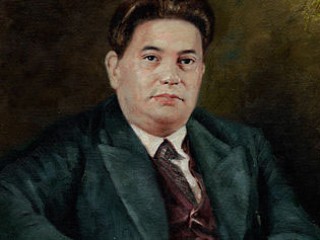
Darius Milhaud biography
Date of birth : 1892-09-04
Date of death : 1974-06-22
Birthplace : Marseilles, France
Nationality : French
Category : Arts and Entertainment
Last modified : 2011-02-13
Credited as : Cpmposer and teacher, La Creation du monde , Les Choephore
The French composer and teacher Darius Milhaud was the main champion of polytonality in the 20th century.
Darius Milhaud was born on Sept. 4, 1892, in Aixen-Provence. His family, descended from a line of Jews established in the region for generations, had the time and means to encourage their son's musical interests: violin lessons at age 7, participation in the quartet organized by his violin teacher at age 13, and studies at the Paris Conservatory (1909-1912) mark the well-planned stages of his student career. Typical of his generation, he voiced a strong distaste for the music of Richard Wagner and an equally strong admiration for Modest Mussorgsky and Claude Debussy. Sensing, nevertheless, the dangers of impressionism for his own development—"too much fog," "too many perfumed breezes"—Milhaud resolved to "break the spell" of Debussy, although "my heart always remained faithful."
Anti-impressionism was undoubtedly one of the two major factors uniting, just after World War I, the group of composers known as Les Six; the author Jean Cocteau was the other. Not a musician and therefore, by his own designation, not eligible for "membership" in the group, Cocteau was nevertheless its guiding spirit. His collaboration with Milhaud resulted in Le Boeuf sur le toit (1919), Le Train bleu (1924), and Le Pauvre matelot (1926). Cocteau also seems to have been responsible for stimulating Milhaud's interest in jazz, which resulted in one of his most enduring works, La Creation du monde (1923).
Yet, for all their success, the Cocteau works do not reveal the essential Milhaud. Before Cocteau there had been the experience of yet deeper formative influence: that of the writer Paul Claudel. On first reading Claudel, in 1911, Milhaud was struck by a "force which shakes the human heart… like an element of nature." The two artists began a long collaboration, which Milhaud said was "the best thing of my life as a musician." They collaborated on Agamemnon (1913), Les Choephores (1915), Les Eumenides (1917-1922), Christophe Colomb (1928), Maximilien (1932), Bolivar (1952-1953), and David (1954).
Claudel was minister of France to Brazil (1917-1919) and took Milhaud along as his secretary. In Rio de Janeiro, Milhaud worked out the details of the technique which, rightly or wrongly, came to be particularly identified with his style: polytonality. What had been a "superimposition of chords proceeding by masses" in Les Choephores was to become in L'Enfant prodigue (1918) a polytonality residing "no longer in chords but in the meetings of lines."
If polytonality was a unifying factor for Milhaud's style, his origins served to define his esthetic: "Latinity, Mediterranean are words which have a deep resonance in me." The locales of his stage works—Greece, Palestine, Mexico, and Brazil—are significant for their strong affinities with his native Provence, and the music of these places furnished him with many melodic and rhythmic ideas. The themes of southern landscape and popular life are so omnipresent in his vocal works that they have tended to obscure his image as a composer of absolute music, that is, music free from extramusical implications.
The number of symphonies (16), concertos (31), and chamber works (about 60) that Milhaud composed is considerable; indeed, in 20th-century terms his production of over 400 works is enormous, a fact which engendered some negative criticism about his work, such as unevenness in quality, inattention to detail, and signs of haste. Such accusations ignore Milhaud's basic motivation as a composer, namely, that the act of creation is more important than the thing created. His production was all the more remarkable in view of his teaching schedule. From 1948 on he spent alternate years in Paris and at Mills College, Calif.
















